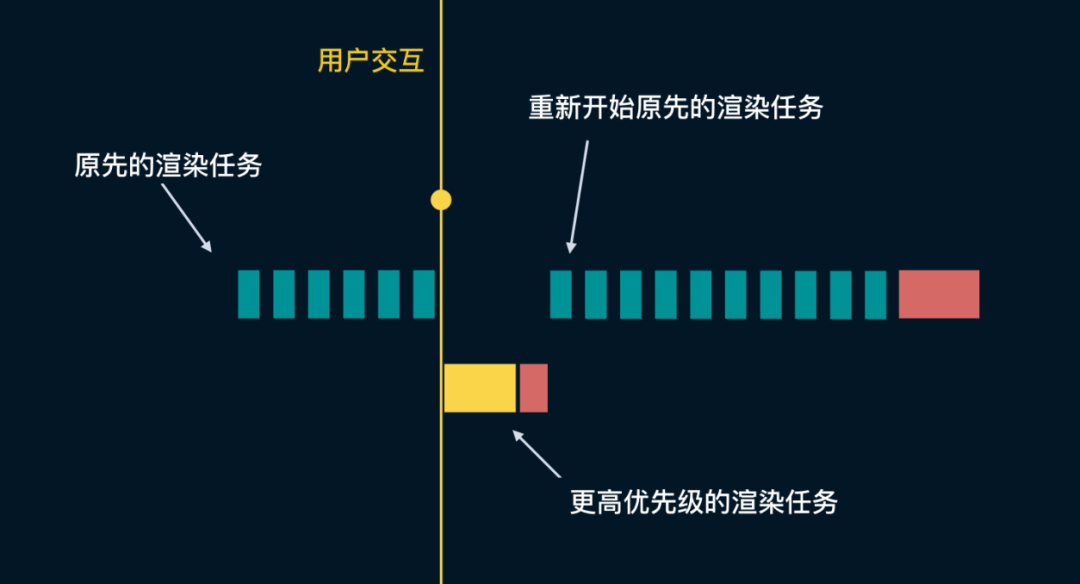简介
react18现有的所有新特性和未来可能的许多变化,都离不开concurrent并发渲染模式
react的并发渲染并不是真正的多线程并发模式,而是使用类似于eventloop的时间切片模式,每个task都可以在运行和暂停两个状态之间切换

汇总
- Concurrent Mode:渲染模型的变化
- Automatic Batching:自动批量更新state变化,减少渲染次数
- Transition:指定渲染优先级
const [isPending, startTransition] = useTransition()code sandboxconst deferredValue = useDeferredValue(value)code sandbox
- Suspense:更方便的组织并行请求和loading状态的代码
如何升级
const container = document.getElementById('app')
// react17 and b4
import { render } from 'react-dom'
render(<App />, container)
// react18
import { createRoot } from 'react-dom/client'
const root = createRoot(container)
root.render(<App />)
重要特性
1.Automatic Batching
自动批量更新state,减少渲染次数;在之前的版本中,react只能处理在react event handler中的state batching,在浏览器事件如
Promise、setTimeout、native event handlers等事件中,均无法batching,每一次状态变更,必然触发一次render。
// b4
setTimeout(() => {
setCount(c => c + 1)
setFlag(f => !f)
// react will render twice, once for each state update(no batching)
})
// after:updates inside of timeouts, promises, native event handlers
// or other event are batched
setTimeout(() => {
setCount(c => c + 1)
setFlag(f => !f)
// react will only re-render once at the end(that's batching)
}, 0)
disable Automatic Batching(Not recommended)
import { flushSync } from 'react-dom'
function handlerClick() {
flushSync(() => {
setCount(c => c + 1)
})
// react has updated the DON by now
flushSync(() => {
setFlag(f => !f)
})
// react has updated the DON by now
}
2.Transitions
- hooks:
useTransition - class:
startTransition
原理
在某些场景下,渲染可以分类为高优先级和低优先级,如搜索功能,输入区域为高优先级,需要实时更新显示为用户当前正在输入的内容;下方搜索结果的展示,则允许有延迟或者误差,全看如何处理:
- 在
startTransition之前,我们通过debouce或者throttle约束搜索结果请求响应的频率,减少无效渲染导致的闪烁以及卡顿,在react18中,相当于react内置了类似的解决方案 - 为什么说全看如何处理,因为通过
startTransition包裹的部分,被react认定为低优先级渲染,需要通过isPending来给这部分延迟更新的DOM做一个fallback方案,否则看起来的效果会比使用startTransition优化之前更卡顿,正确理解很关键 - 额外需要注意的是,在渲染强度不高的场景下,
isPending看起来会没有效果,因为渲染开销并不大
核心代码
import React, { useState, useTransition } from "react";
export function FilterList({ names }) {
const [query, setQuery] = useState("");
const [highlight, setHighlight] = useState("");
const [isPending, startTransition] = useTransition();
const changeHandler = ({ target: { value } }) => {
setQuery(value);
startTransition(() => setHighlight(value));
};
return (
<div>
<input onChange={changeHandler} value={query} type="text" />
{isPending
? "loading..."
: names.map((name, i) => (
<ListItem key={i} name={name} highlight={highlight} />
))}
</div>
);
}
function ListItem({ name, highlight }) {
const index = name.toLowerCase().indexOf(highlight.toLowerCase());
if (!highlight) {
return <div>{name}</div>;
}
if (highlight && index !== -1) {
return (
<div>
{name.slice(0, index)}
<span className="highlight">
{name.slice(index, index + highlight.length)}
</span>
{name.slice(index + highlight.length)}
</div>
);
}
return undefined;
}
运行demo查看效果
3.fetch as you render(Suspense)
场景
设想一个场景,我们渲染一个组件A,依赖两个API获取数据(非强制依赖关系,任意一个完成即可开始渲染工作),一般的写法
// fetch A then render
// fetch B then render
但是这样有一个问题,就是A或者B完成以后,一定会触发渲染,在渲染完成之前,另一个响应如果完成,并不能立即进行渲染更新,必须等待前一个渲染完成以后才行,造成了渲染性能浪费
那我们很容易想到,可以通过A+B并发的形式,等待A和B数据全部获取到以后,再进行渲染工作。
// fetch A+B
Promise.all([A, B]).then(data => handleWithData(data))
但是这样会有另外的问题,假如任意一个接口响应卡慢,就会导致迟迟无法更新DOM渲染,十分影响体验。这里有兴趣的话,我们可以实现一个promise.alldeal方法,一次将所有传入的请求分别包装成单个promise请求,每个完成以后,都自动执行callback,有失败的,则返回对应list(包含唯一id、请求函数、绑定作用域的回调函数等信息)
react18之前,react是单向渲染流程,即渲染一旦启动,无法暂停,在当前渲染完成之前,无法做接下来的渲染工作;但是引入concurrent并发渲染模式以后,这将不是一个问题。
react支持以下两种渲染方式:
- fetch then render: 获取到数据以后再渲染
- fetch as you render: 边渲染边获取数据
原理
- 启动
suspense会根据条件渲染所有组件或其fallback - 在条件没有发成或数据没有加载完成时,会先渲染fallback指定的组件
- 一旦有数据加载成功,react会向上寻找最近的
suspense组件,解除pending状态
但是要真实达到这个效果,react需要知道当前suspense包裹的数据是否加载完成,如何知道呢?可以看看官方的Suspense Demo
这对三方请求的API提出了要求,在数据未加载完成时,需要通过throw promise的方式,将这个pending状态的请求抛出,react会catch这个请求,设置一个当前suspense的pending状态,显示fallback的内容,一旦请求完成,react解除pending状态,触发重新渲染即可,通过以上的方式,达到了fetch as you render的并发渲染状态
function Component() {
if (data) {
return <div>{data.message}</div>
}
throw promise
// react will catch this, find the closest 'suspense' component
}
ReactDOM.createRoot(rootEl).render(
<Suspense fallback={'loading..'}>
<Component />
</Suspense>
)
react18解决方案
const resource = fetchProfileData()
function ProfilePage() {
return (
// 两个suspense包裹的内容会同时加载
<Suspense fallback={<h1>loading profile...</h1>}>
<ProfileDetails />
<Suspense fallback={<h1>loading posts...</h1>}>
<ProfileTimeline />
</Suspense>
</Suspense>
)
}
function ProfileDetails() {
const user = resource.user.read()
return <h1>{user.name}</h1>
}
function ProfileTimeline() {
const posts = resource.posts.read()
return (
<ul>
{posts.map(post => (
<li key={post.id}>{post.text}</li>
))}
</ul>
)
}
4. useDeferredValue
- 通过声明defer,react会优先处理紧急更新,声明defer的值在紧急更新完成之前会先使用旧的值,在紧急更新完成以后,转而进行该部分非紧急更新
- 和通过debounce、throttle进行defer update原理类似,但是:
- defer部分的更新是暂停的,不会触发该部分内容的回退
- 和debounce、throttle通过僵硬的一个固定time进行优化相比,react可以在其他工作完成以后,立即进行这部分更新,从时机上,更优化
function Typeahead() {
const query = useSearchQuery('');
const deferredQuery = useDeferredValue(query);
// Memoizing tells React to only re-render when deferredQuery changes,
// not when query changes.
const suggestions = useMemo(() =>
<SearchSuggestions query={deferredQuery} />,
[deferredQuery]
);
return (
<>
<SearchInput query={query} />
<Suspense fallback="Loading results...">
{suggestions}
</Suspense>
</>
);
}
[1] react-v18